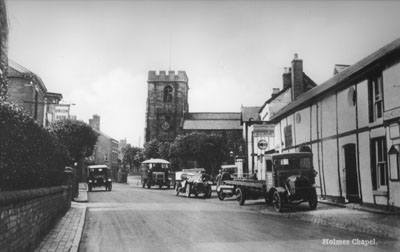Sources (Available in the local library)
Earwaker – The History of the Ancient Parish of Sandbach
Holmes Chapel Parish Church by Rosemary Scott
A Journey Through Time by The Holmes Chapel Research Group, initially published in 1996, this was revised in 2017 and printed as a series of 3 booklets which can be obtained from Holmes Chapel Library at a cost of £3 each.
Holmes Chapel – A Stroll Through the Past. By the Holmes Chapel Research Group.
Holmes Chapel - A Brief History

Holmes Chapel has developed from a small village at a cross roads. On the main route from London to Lancashire, it catered for travellers at its inns and served the surrounding farming community.
In its infancy it was known as Holmes Chapel, Church Hulme and Hulmes Chapel, Today the name Church Hulme is mainly used for the ecclesiastical Parish of Church Hulme, made up of the three townships of Holmes Chapel, Cranage and Cotton.
The village built up around the cross roads and the church, forming The Square which was a focal point of the village with many social functions including fairs and a cattle market occurring there. That is how it remained for many years with a gradual development along the four arms of the crossroads.
The Square, now a conservation area, reaches from the mini roundabouts on the north side of the village to the pedestrian crossing at the south. The northern boundary was originally formed by the old George and Dragon and the Bulls Head (demolished in 1948) which were either side of Knutsford Road. The old George and Dragon was demolished in 1970 and a new building erected at the current location to make way for the widening of the Middlewich and Knutsford Roads.
A chapel has been a feature of the village since earliest times with a church present on the site from at least the 13th century when it was a chapel of ease to the mother church in Sandbach.

The current church dates from the 15th century. Although originally of timber frame construction, an extensive 18th century enlargement added the stone facing which can be seen today but the original timber frames are still intact and can be seen inside the church. The Parish Registers survive from 1613 and some Bishops Transcripts from 1597. Of the few stained glass windows in the Church, the east window is a memorial to the men who died in World War 1.
In 1753 the village consisted of nineteen buildings. In July of that year, fifteen were destroyed by fire. The Church, the Red Lion and two cottages survived. Hence, most of the village buildings are no older than the 18th century.
Much of the development after the fire was done by the principal land owners, the Hall family, who lived at The Hermitage. Many buildings around Holmes Chapel can be seen with a stone showing TBH and a date (example - above Bridgefords in The Square). T.B.H. was the initials of Thomas Bayley Hall the last member of the Hall family at The Hermitage. Thomas Bayley Hall’s estates were sold to various people after his death in 1828.
The Old Red Lion dates from the 17th century, if not before, the earliest documentary evidence found being the will and inventory of Thomas Gandie dated 1625.
Many travellers rested here with stage coaches calling daily. In 1738 John Wesley paid his first visit to Holmes Chapel whilst on route from Oxford to Manchester. He rested and preached a sermon at the Red Lion Inn.
The village was mainly self sufficient, serving the local population, the surrounding farms, which also provided employment, and passing trade promoted work at the inns.
A forge was established by 1840 although the site has been run by the Dale family since 1927 as an agricultural engineers and farm suppliers. Other family businesses which have existed for many generations include Mandeville’s bakery (est. 1900), Williams’ grocers (1875 to 2013) and Morrey’s general hardware store (1850).
